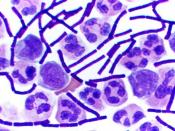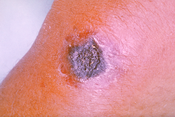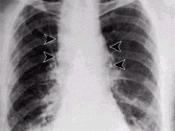Bio War
ANTHRAX
Anthrax: The "Acute infectious disease," is a spore forming bacteria called "Bacillus Anthracis". It is mostly found in hoofed animals, and is very deadly. It can be caught in 3 forms: Cutaneous Anthrax, Inhalation Anthrax, and Gastrointestinal Anthrax. All of these forms of the disease can be prevented.
The first use of anthrax as a weapon was against Germany in World War 1. British intelligence documents show that from 1916-1918 reveal that the Germans infected nearly 5,000 mules and horses in Mesopotamia, and that in August 1916 sent anthrax to Romania to infect sheep being transported to Russia. In World War 2, Japanese agents developed anthrax-infected chocolates and chewing gum, fountain pens, hatpins, and even umbrellas tipped with the disease.
Anthrax was discovered by Robert Koch, in 1877, which grew the organism in "pure culture". His original micrographs of the anthrax were very large, Gram-positive, and spore-forming rod shaped.
It can survive in aerobic or anaerobic conditions. It is very similar genotypically and phenotypically to Bacillus cereus and bacillus thuringiensis.
The pathology of anthrax can come in 3 different forms: Cutaneous, Gastrointestinal, and Inhalation. Cutaneous is the least deadly form of anthrax. This form is contracted through the skin. It is not very serious, affecting humans only by forming a mere "spore" or "blister" on the skin, then turning into an ulcer. Inhalation is the 2nd deadliest form, which is of course inhaled through the nose or mouth. It starts out with symptoms of the common cold, then gradually gets worse, turning into severe fever, severe chest pains, and shortness of breath. Gastrointestinal form of this disease is the deadliest. This is caused by eating infected animal meat and affects the digestive system. The symptoms include nausea, vomiting, and fever, then later turning into...


